Development and validation of a predictive score for perioperative transfusion in patients with hepatocellular carcinoma undergoing liver resection
Chengdu, China
Development and validation of a predictive score for perioperative transfusion in patients with hepatocellular carcinoma undergoing liver resection
Hai-Qing Wang, Jian Yang, Jia-Yin Yang, Wen-Tao Wang and Lu-Nan Yan
Chengdu, China
BACKGROUND: Liver resection is a major surgery requiring perioperative blood transfusion. Predicting the need for blood transfusion for patients undergoing liver resection is of great importance. The present study aimed to develop and validate a model for predicting transfusion requirement in HBV-related hepatocellular carcinoma patients undergoing liver resection.
METHODS: A total of 1543 consecutive liver resections were included in the study. Randomly selected sample set of 1080 cases (70% of the study cohort) were used to develop a predictive score for transfusion requirement and the remaining 30% (n=463) was used to validate the score. Based on the preoperative and predictable intraoperative parameters, logistic regression was used to identify risk factors and to create an integer score for the prediction of transfusion requirement.
RESULTS: Extrahepatic procedure, major liver resection, hemoglobin level and platelets count were identifed as independent predictors for transfusion requirement by logistic regression analysis. A score system integrating these 4 factors was stratifed into three groups which could predict the risk of transfusion, with a rate of 11.4%, 24.7% and 57.4% for low, moderate and high risk, respectively. The prediction model appeared accurate with good discriminatory abilities, generating an area under the receiver operating characteristic curve of 0.736 in the development set and 0.709 in the validation set.
CONCLUSIONS: We have developed and validated an integerbased risk score to predict perioperative transfusion for patients undergoing liver resection in a high-volume surgicalcenter. This score allows identifying patients at a high risk and may alter transfusion practices.
(Hepatobiliary Pancreat Dis Int 2015;14:394-400)
liver resection;
transfusion;
hepatocellular carcinoma
Introduction
Hepatocellular carcinoma (HCC) is one of the most lethal malignancies and liver resection is the only potentially curable treatment.[1]Despite advances in the surgical and anesthetic techniques in the last decades, perioperative transfusion is required in 19.2% to 50% of the cases.[2,3]With stricter donor selection criteria and a decreased interest in voluntary blood donation,[4]blood shortage is becoming a new threat for patients requiring transfusion. Studies[3,5]have shown that the blood routinely ordered for surgery is never utilized completely, resulting in resource misallocations. In addition, transfusion of allergenic blood is also associated with increased risk of infection, incompatibility and adverse immunomodulatory effect resulting in greater risk of tumor recurrence and poor prognosis.[6]Recognizing these potential disadvantages and the increased fragility of the national blood supply in recent years, cross-matching and transfusion policies need to be rationalized.[2]
Alternative strategies for the management of blood transfusion include preoperative autologous blood donation (PABD), acute normovolemic hemodilution (ANH), and cell salvage.[3]Cell salvage cannot be carried out for HCC patients because it has the potential for reintroducing tumor cells. PABD and ANH are safe and effective blood conservation techniques and can also reduceheterologous blood transfusion.[2]However, these techniques are economically effcient only if directed toward patients with a high risk of transfusion.[7]Preoperative identifcation of patients at a high risk of transfusion would permit cross-matching of additional units or consideration of further blood conservation strategies for this group.
This study aimed to develop and validate a simple score based on preoperative and predictable intraoperative parameters to stratify patients before surgery into risk categories for transfusion requirement of packed red blood cells (PRBCs) in hepatitis B virus (HBV)-related HCC patients. This score would help to avoid excess cross-match and unnecessary autologous blood conservation.
Methods
Population and study design
Between January 2009 and March 2013, 1543 consecutive HBV-related HCC patients undergoing elective liver resection were included. All the included patients were diagnosed with HCC by histology and were either HBV positive or had a history of HBV infection. Only patients with Child-Turcotte-Pugh (CTP) score of A underwent surgery. Patient records of pre-, intra- and postoperative parameters, and blood transfusion were collected retrospectively from the West China Hospital of Liver Cancer Registry Database. The protocol was approved by the West China Hospital Ethical Committee and written informed consents were obtained from all patients before inclusion. Based on the perioperative transfusion requirement, the cohort was divided into two groups (transfusion group and non-transfusion group) to identify risk factors for perioperative transfusion. To develop and validate a predictive score for perioperative transfusion stratifcation, the cohort was split randomly into development group (randomly selected 70% of the cohort) and validation group (the remaining 30%).
Perioperative management
All the included patients underwent a thorough case history enquiry, physical examination and routine preoperative laboratory measurements. Routine preoperative imaging examination to evaluate the tumor included contrast computed tomography or magnetic resonance imaging of the abdomen. Patients were explored through an extended right subcostal incision and intraoperative ultrasonography was performed routinely. Hemihepatic vascular infow occlusion[8]or Pringle maneuver[9]was used according to the surgeon's preference in most patients. Liver parenchymal transection was performed using the hooking ligation technique[8,10]or an ultrasonic dissector with coagulator.
Patients were routinely cross-matched for 5 units of PRBCs before surgery. One unit of PRBCs contains approximately 200 mL of blood. Transfusion was carried out when the hemoglobin level was less than 70 g/L in stable patients and less than 80 g/L in patients with disturbed hemodynamics, according to the AABB guideline.[11]Fresh-frozen plasma was given if the international normalized ratio (INR) was higher than 1.5.
Description of parameters
Blood transfusion was defned as the number of units of PRBCs transfusion during the operation and postoperative period.[7]Transfusion with other blood products, such as fresh-frozen plasma, platelets and albumin, were not considered as blood transfusion. Liver resection of more than three segments was defned as major resection, and that of fewer than three segments was defned as minor resection.[12]Extrahepatic procedures included vascular surgical procedures mainly involving in resection of tumor thrombus of the portal vein, hepatic vein or vena vein and operations of other organs except for liver resections, including bowel resection, colectomy, adrenalectomy, diaphragm resection, splenectomy, portalazygous disconnection and others. The Clavien-Dindo complications classifcation system[13]was used for grading of postoperative complications and complication grades of III-V were considered as severe complications. Portal hypertension was defned as esophageal varices detected by endoscopy or as a splenomegaly (major diameter >12 cm) with a platelet count <100×109/L according to the Barcelona Clinic Liver Cancer group criteria.[14]For individual preexisting disease, we used a modifcation of Charlson index[15]to quantify comorbidities.
Selection of predictive parameters and strategy for score development
We followed the standard approach[16,17]to develop and validate a predictive score. We frst compared the pre-, intra- and postoperative clinical features between the transfusion group and non-transfusion group by univariate analysis. Only preoperative and predictable intraoperative variables with signifcant difference on univariate analysis were considered for the development of prediction model for transfusion requirement. We randomly selected 70% of the whole cohort as the score development group (1080 patients). The randomization was performed using a computerized random number generator. All the variables associated with transfusion requirement in the univariate model at a signifcancelevel α=0.05 were chosen for the multivariate logistic regression analysis to evaluate their independent predictive value. The regression coeffcients were transformed into integer-based weighted point system for stratifying transfusion requirements. The referent for each variable was assigned a value of zero. For the remaining values of the variables, a value from 0 to 3 was respectively given to the variables based on the beta coeffcient. The points for all predictors were added to get the individual risk score. The risk scores were stratifed into three groups (low, moderate and high risk) based on their numerical values. At last, the score was validated in the remaining 30% of the patients.
Statistical analysis
Data were expressed as mean±standard deviation (SD) or median and interquartile range. Statistical analysis was performed using SPSS version 17.0 statistical analysis software. Student's t test and the Mann-Whitney U test were used to compare continuous variables when appropriate. The Chi-square test and Fisher's exact test were used to compare categorical variables. Variables showing signifcance at P<0.05 on univariate analysis were entered into a forward wald logistic multiple regression analysis, and a transfusion risk score was developed. The accuracy of the system was validated by calculating the area under the receiver operating characteristic (ROC) curve. The level of signifcance was set at P<0.05.
Results
Study population and transfusion
A total of 1543 consecutive liver resections for HBV-related HCC were included in our study. Total 127 patients were involved in extrahepatic procedures, including 55 portal vein tumor thrombus resections (43.3%), 28 diaphragm resections (22.0%), 16 splenectomies (12.6%), 13 gastrointestinal tract resections (10.2%), 6 operations involving in the hepatic vein or vena vein (4.7%), 9 adrenalectomies and others (7.1%). Variables potentially related to the probability of transfusion are summarized in Tables 1 and 2. A total of 7715 units PRBCs were crossmatched preoperatively. During the perioperative period, 288 patients (18.7%) received 1345 units PRBCs, with a median transfusion of 3.5 units. During the operation, 1205 (89.6%) units PRBCs were transfused. The overall cross-match to transfusion ratio was about 5.7:1. Only 17.4% of the cross-matched PRBCs were used and the remaining 82.6% were returned back.
Compared to non-transfusion patients, the transfusion patients had poorer postoperative outcomes (Table 2),with a signifcant increase in intensive care unit (ICU) stay (1 vs 0 day, P<0.001) and hospital stay (15 vs 12 days, P<0.001). Compared with non-transfused patients, transfusion patients had signifcantly higher postoperative morbidity (50.0% vs 25.5%, P<0.001) and mortality (4.5% vs 0.8%, P<0.001). In addition, non-transfusionpatients had fewer severe complications than transfusion patients (5.7% vs 18.4%, P<0.001).
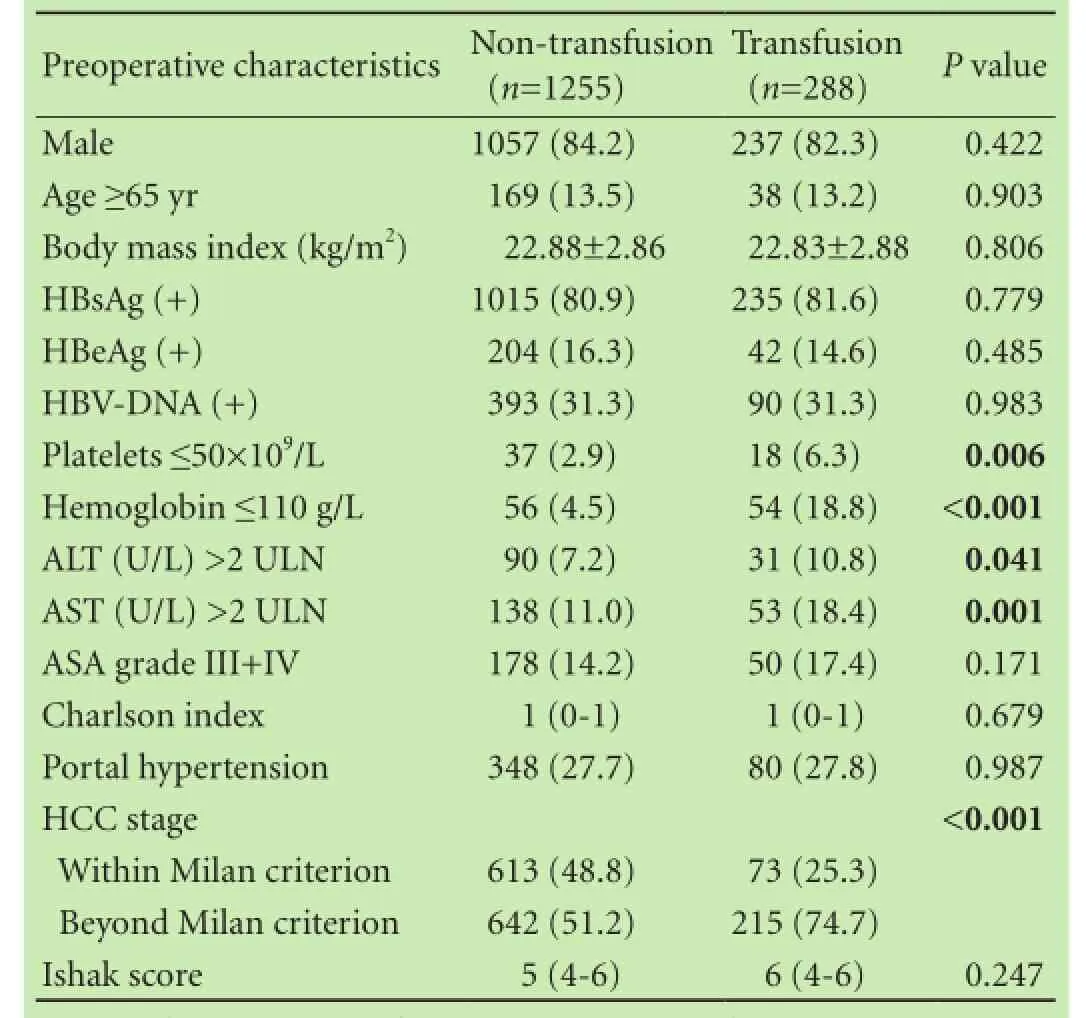
Table 1. Preoperative characteristics of patients with hepatocellular carcinoma (n, %)
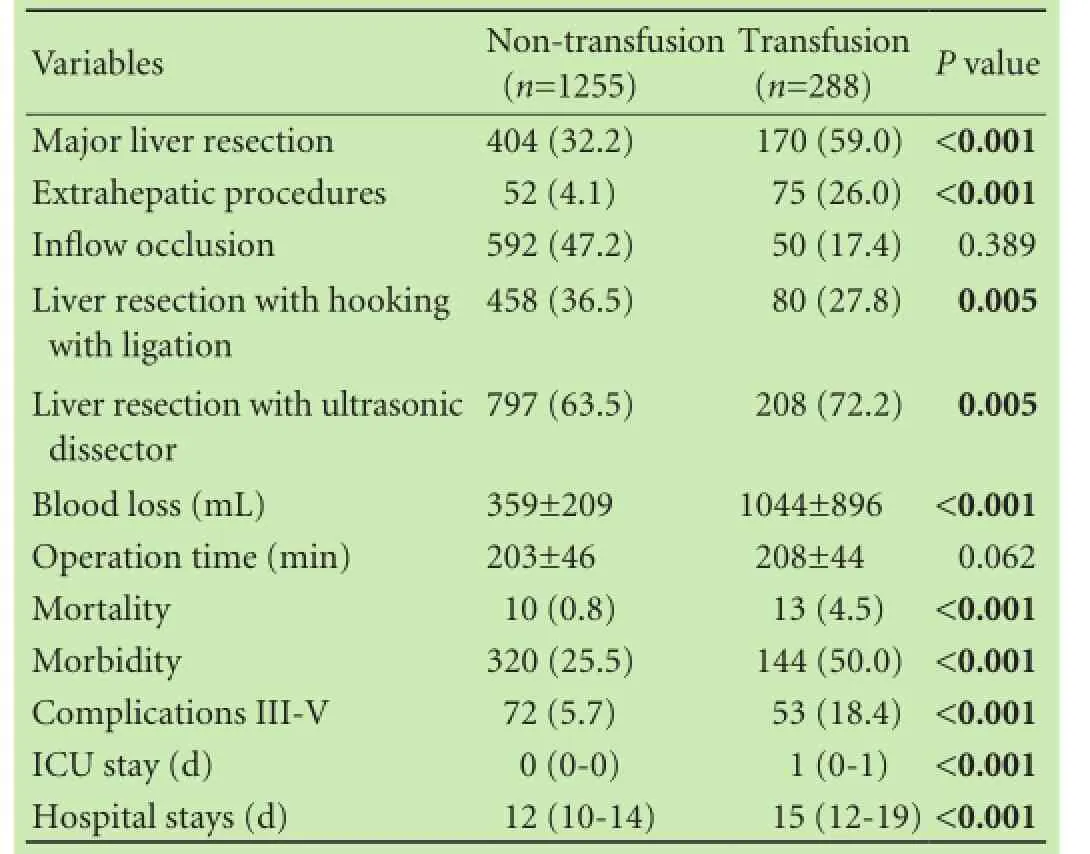
Table 2. Intraoperative parameters and postoperative outcomes (n, %)
Development of the predictive score
Univariate analysis (Tables 1 and 2) showed that fve preoperative factors including platelets count, hemoglobin level, ALT, AST, HCC stage and two intraoperative factors including extrahepatic procedures and extent of liver resection were signifcantly different (P<0.05) between transfusion and non-transfusion groups. Higher ALT and AST levels in the transfusion group may be caused by severe liver damage due to larger tumors. Though the two factors of extrahepatic procedures and extent of liver resection were intraoperative factors, they were still considered as predictive factors because they usually could be predicted by imageology examination and operation plan before surgery. The other signifcant intraoperative factor such as blood loss was not considered because of the unpredictability in preoperative situation. In addition, we selected the extent of liver resection as a predictor to indirectly refect the surgical trauma, rather than HCC stage, because the resection extent was not only based on tumor size but also on the location of tumor in the liver. To develop the prediction model, 1080 patients (70% of the cohort) were randomly selected as a derivation population and the remaining 30% patients (n=463) were evaluated for the score validation. The above seven risk factors were selected for inclusion in the logistic regression analysis (Table 3) and the results showed that the extent of liver resection, platelets count, hemoglobin level and extrahepatic procedures were signifcantly different (P≤0.003). The regression coeffcients were transformed into an integer-based weighted point system for clinical practice. Based on the value of regression coeffcient, each variable was assigned a score from0 to 3 and total scores were added up for every patient. As a reference, minor liver resection, non-extrahepatic procedure, hemoglobin level >110 g/L and platelets >50 × 109/L were assigned a score of zero. Extrahepatic procedures showed the greatest association (β=1.936) with transfusion risk, followed by hemoglobin level ≤110 g/L (β=1.663), platelets ≤50 ×109/L (β=1.183) and major liver resection (β=1.127). Platelets ≤50×109/L and major liver resection shared similar and lowest regression coeffcients (1.183 and 1.127), so they were assigned a score of 1. Extrahepatic procedures and hemoglobin level ≤110 g/L were assigned a score of 3 and 2 based on their value of regression coeffcients which were more than platelets≤50×109/L and major liver resection's. The total scores (ranging from 0 to 7 points) were grouped into three groups (score 0-2 for low, score 3-4 for moderate and score 5-7 for high risk group) based on clinically relevant estimated transfusion risks. Patients with higher score had a greater requirement perioperative transfusion. The incidence of transfusion was 11.4%, 24.7% and 57.4% for low, moderate and high risk group, respectively. The model discriminated with an area under the ROC curve of 0.736 in the development set (Fig. 1, P<0.001). In addition, the number of units of blood transfused correlated signifcantly with the risk score (P=0.044, bivariate Spearman's rank-order correlation test).
Validation of the prediction model
The model discriminated well in the development set with an area under the ROC curve of 0.736. The remaining 463 (30%) patients were used for the validation of the prediction model. The model continued to show a good discrimination with an area under the ROC curve of 0.709 (P<0.001) based on the multivariate model (Fig. 2). The incidences of transfusion in the validation group were19.9%, 28.8% and 66.7% for low, moderate and high risk group, respectively, with a good discrimination.
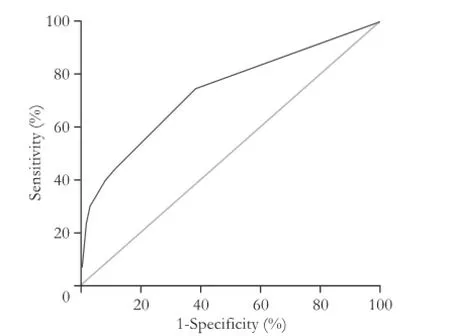
Fig. 1. ROC curve analysis of preoperative risk factors to predict transfusion requirement in the development group (area under the curve=0.736, P<0.001).
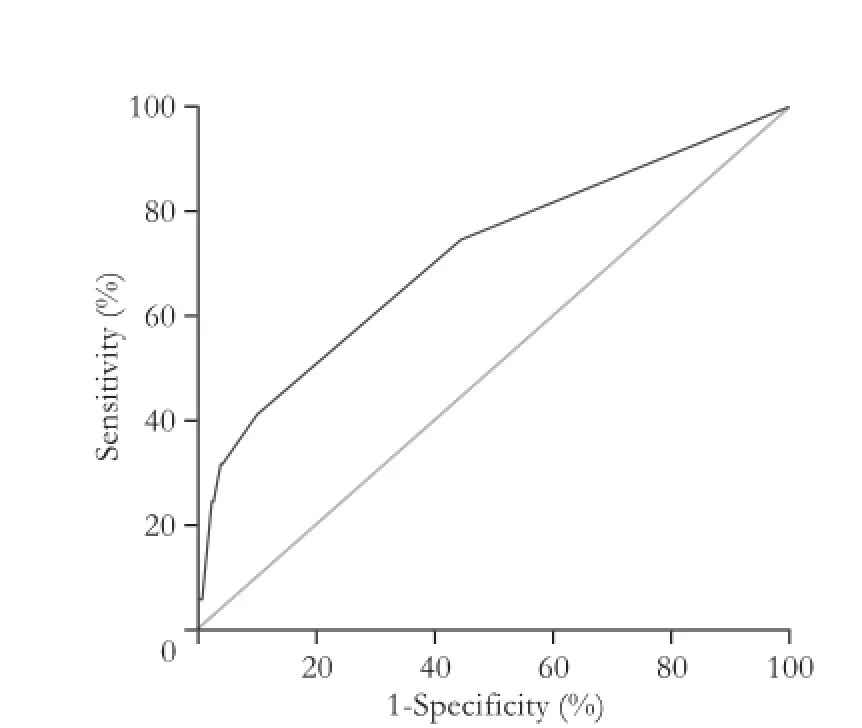
Fig. 2. ROC curve analysis of preoperative risk factors to predict transfusion requirement in the validation group (area under the curve=0.709, P<0.001).
Discussion
In China, a high prevalence of HBV carriage has contributed to 80% of the HCC.[18]Liver resection is an important therapeutic method, but is generally associated with signifcant blood loss and blood transfusion requirement. Blood transfusion increases the morbidity, mortality[2]and also infuences the overall and disease-free survival rates of HCC patients.[6]
In our cohort, the blood transfusion rate was 18.7%, with a median transfusion of 3.5 units, which was comparable to contemporary published results for liver resection.[3,7,19-21]We observed an association between massive transfusion and poor postoperative outcomes, such as severe complications, lengthened hospitalization and ICU stays in our study. Like other reports earlier,[7,19]we also observed that the number of blood units cross-matched signifcantly exceeded the units actually transfused to the patients. The cross-match to transfusion ratio was about 5.7:1 and only 17.4% of the blood was used, resulting in the remaining 82.6% being discarded. Our cross-match to transfusion ratio was more than the 2:1 ratio recommended by Friedman and colleagues (maximum surgical blood order schedule, MSBOS).[22]The low transfusion rate and high cross-match to transfusion ratio in this study indicated the irrationality of current cross-match and necessity of a reliable risk stratifcation for transfusion. Based on preoperative and predictable intraoperative parameters, we developed a model including four independent parameters for predicting transfusion requirement with good discrimination ability. Our results suggested that extrahepatic procedures, hemoglobin levels ≤110 g/L, platelets ≤50×109/L and major liver resection were important predictors of transfusion requirement. These predictors were related to surgery trauma, coagulation status and relative anemia status, which were associated with blood loss and consequent transfusion requirement. For clinical usability, we integrated the four parameters in a simple prediction score system that can be conveniently used by surgeons for making clinical decisions. The score system also showed excellent discrimination of different levels of risk for blood transfusion (low, moderate and high) among 3 risk groups, with a risk rate of 11.4%, 24.7% and 57.4%, respectively.
Extrahepatic procedure was the most obvious predictor for perioperative transfusion requirement and this risk factor was also proved by other studies.[3,7]In our cohort, 48.3% of the extrahepatic procedures were associated with major vascular procedures which had been proved to be hemorrhagic procedures in most liver resections[21]because of the sudden large blood loss during operation.[7]Extrahepatic procedures such as diaphragm resection, splenectomy, and gastrointestinal tract resection were other possible procedures which induced additional blood loss and increased the risk for transfusion.[12,23]
Our multivariable analysis also showed that hemoglobin level ≤110 g/L was another predictor for perioperative transfusion. This observation was consistent with other studies.[3,7,19-21,24]Symptomatic manifestations of low hemoglobin level arose only when its concentration was less than two thirds of the normal (i.e., <90-100 g/L).[25]An earlier study indicated[25]that when the hemoglobin level is less than 80-100 g/L, the blood transfusion is needed before operation. Considering the inevitable blood loss during operation, we set the threshold value of hemoglobin level at 110 g/L, which proved to be an obvious predictor for transfusion in other studies.[26,27]
In patients with HBV-related HCC, cirrhosis and portal hypertension are common and always affect the mortality and morbidity.[28]However, our univariate analysis showed that portal hypertension was not associated with the risk of blood transfusion. Liver resection in cirrhotic liver can increase the risk of blood loss and may be a risk factor for transfusion;[29]however, cirrhosis can be diagnosed only by pathological methods. Thrombocytopenia is associated with liver cirrhosis,[30]portal hypertension[14]and coagulopathy. Thrombocytopenia represents the degree of cirrhosis. Our results showed that a platelets count of ≤50×109/L was a predictor for perioperative transfusion. INR, another index for coagulation status, was not included in our model, because it is a component of CTP score. Major liver resection could induce more blood loss and was associated with transfusion in our study, which has also been proved by many other studies.[3,7,19-21,24]
Similar studies[3,7,19-21,24]have also developed simplescores to predict the risk of transfusion in liver resection by preoperative parameters based on similar markers, such as hemoglobin, extrahepatic procedure and the extent of liver resection. Only two studies[3,20]identifed platelets count as a risk factor. Some studies,[3,7,19,20]also identifed different predictors from ours, including primary liver disease, preoperative biliary drainage,[19]and coronary artery disease.[19]Probably all the patients in our cohort had HBV-related HCC, whereas other studies included all kinds of liver tumors.
Several limitations existed in our study. First, the results of our study should be interpreted cautiously because of the absence of validation in other liver resection centers. Second, we only included preoperative and predictable intraoperative factors in our model, and other factors such as fbrosis severity and blood loss were not included. The accuracy of the model would be affected by these factors. Third, our study was restricted to patients with HBV-related HCC because 80% of the HCC in China were due to HBV infection. Only patients with a CTP score of A were considered for liver resection in our center. Thus surgeons need to be cautious in applying this model for patients with HCV-related HCC, cirrhosis and other liver diseases.
This prediction model represented a stratifcation of the risk for transfusion requirement in patients undergoing liver resection for HBV-related HCC. Using the risk score, patients could be stratifed into low, moderate and high risk groups before surgery. In order to improve the cost-effectiveness of the cross-match and autogenic blood conservation technique, we advocated an individual protocol based on our prediction model. For a score of 0-2, operation could be done even without blood preparation because the risk rate for transfusion is 11.4% and most blood transfusion services could be provided in time if transfusion required. For a score of 3-4, patients should be encouraged to use the autogenic blood conservation technique. But for a score of 5-7, the risk rate for transfusion requirement is 57.4% and it is more than the prescribed criterion for autogenic blood conservation.[31]However, low preoperative hemoglobin level is a contraindication to autologous blood donation and should be considered in this condition. A prospective randomized trial[2]found that the hemoglobin level of 130 g/L was safe for autogenic blood conservation technique. So, for patients with hemoglobin level more than 130 g/L with a transfusion risk score of 5-7, autogenic blood conservation technique should be encouraged. For patients with hemoglobin level less than 130 g/L and transfusion risk score of 5-7, at least 3.5 units of PRBCs should be crossmatched by weighing against patient safety, since the median transfusion requirement in our study was 3.5 units.
In conclusion, the current study, based on a large sample size, developed and validated a risk prediction score system for blood transfusion in liver resection in HBV-related HCC patients. This score allows identifying patients at a high risk and may alter transfusion practices.
Contributors:YLN proposed the study. WHQ and YLN performed research and wrote the frst draft. YJ, YJY and WWT collected and analyzed the data. All authors contributed to the design and interpretation of the study and to further drafts. YLN is the guarantor.
Funding:This study was supported by grants from the National Science and Technology Major Project of China (2012ZX10002-016 and 2012ZX10002-017).
Ethical approval:The protocol was approved by the West China Hospital Ethical Committee and written informed consents were obtained from all recipients before inclusion.
Competing interest:No benefts in any form have been received or will be received from a commercial party related directly or indirectly to the subject of this article.
1 Cescon M, Vetrone G, Grazi GL, Ramacciato G, Ercolani G, Ravaioli M, et al. Trends in perioperative outcome after hepatic resection: analysis of 1500 consecutive unselected cases over 20 years. Ann Surg 2009;249:995-1002.
2 Jarnagin WR, Gonen M, Maithel SK, Fong Y, D'Angelica MI, Dematteo RP, et al. A prospective randomized trial of acute normovolemic hemodilution compared to standard intraoperative management in patients undergoing major hepatic resection. Ann Surg 2008;248:360-369.
3 Sima CS, Jarnagin WR, Fong Y, Elkin E, Fischer M, Wuest D, et al. Predicting the risk of perioperative transfusion for patients undergoing elective hepatectomy. Ann Surg 2009;250:914-921.
4 Hofand J, Henny CP. Bloodless (liver) surgery? The anesthetist's view. Dig Surg 2007;24:265-273.
5 Ayantunde AA, Ng MY, Pal S, Welch NT, Parsons SL. Analysis of blood transfusion predictors in patients undergoing elective oesophagectomy for cancer. BMC Surg 2008;8:3.
6 Makino Y, Yamanoi A, Kimoto T, El-Assal ON, Kohno H, Nagasue N. The infuence of perioperative blood transfusion on intrahepatic recurrence after curative resection of hepatocellular carcinoma. Am J Gastroenterol 2000;95:1294-1300.
7 Pulitanò C, Arru M, Bellio L, Rossini S, Ferla G, Aldrighetti L. A risk score for predicting perioperative blood transfusion in liver surgery. Br J Surg 2007;94:860-865.
8 Wen T, Chen Z, Yan L, Li B, Zeng Y, Wu G, et al. Continuous normothermic hemihepatic vascular infow occlusion over 60 min for hepatectomy in patients with cirrhosis caused by hepatitis B virus. Hepatol Res 2007;37:346-352.
9 Pringle JH. V. Notes on the arrest of hepatic hemorrhage due to trauma. Ann Surg 1908;48:541-549.
10 Yan LN, Yuan CX, Zhang ZD. Hepatopetal blood occlusion of half liver during hepatectomy in 29 patients. Zhonghua Wai Ke Za Zhi 1994;32:35-36.
11 Carson JL, Grossman BJ, Kleinman S, Tinmouth AT, Marques MB, Fung MK, et al. Red blood cell transfusion: a clinical prac-tice guideline from the AABB*. Ann Intern Med 2012;157:49-58.
12 Breitenstein S, DeOliveira ML, Raptis DA, Slankamenac K, Kambakamba P, Nerl J, et al. Novel and simple preoperative score predicting complications after liver resection in noncirrhotic patients. Ann Surg 2010;252:726-734.
13 Dindo D, Demartines N, Clavien PA. Classifcation of surgical complications: a new proposal with evaluation in a cohort of 6336 patients and results of a survey. Ann Surg 2004;240:205-213.
14 Bruix J, Sherman M; Practice Guidelines Committee, American Association for the Study of Liver Diseases. Management of hepatocellular carcinoma. Hepatology 2005;42:1208-1236.
15 Charlson ME, Pompei P, Ales KL, MacKenzie CR. A new method of classifying prognostic comorbidity in longitudinal studies: development and validation. J Chronic Dis 1987;40:373-383.
16 Steyerberg EW, Borsboom GJ, van Houwelingen HC, Eijkemans MJ, Habbema JD. Validation and updating of predictive logistic regression models: a study on sample size and shrinkage. Stat Med 2004;23:2567-2586.
17 Laupacis A, Sekar N, Stiell IG. Clinical prediction rules. A review and suggested modifcations of methodological standards. JAMA 1997;277:488-494.
18 Lau WY, Lai EC. Hepatocellular carcinoma: current management and recent advances. Hepatobiliary Pancreat Dis Int 2008;7:237-257.
19 Cockbain AJ, Masudi T, Lodge JP, Toogood GJ, Prasad KR. Predictors of blood transfusion requirement in elective liver resection. HPB (Oxford) 2010;12:50-55.
20 McCluskey SA, Karkouti K, Wijeysundera DN, Kakizawa K, Ghannam M, Hamdy A, et al. Derivation of a risk index for the prediction of massive blood transfusion in liver transplantation. Liver Transpl 2006;12:1584-1593.
21 Mariette D, Smadja C, Naveau S, Borgonovo G, Vons C, Franco D. Preoperative predictors of blood transfusion in liver resection for tumor. Am J Surg 1997;173:275-279.
22 Friedman BA, Oberman HA, Chadwick AR, Kingdon KI. The maximum surgical blood order schedule and surgical blood use in the United States. Transfusion 1976;16:380-387.
23 Oussoultzoglou E, Jaeck D, Addeo P, Fuchshuber P, Marzano E, Rosso E, et al. Prediction of mortality rate after major hepatectomy in patients without cirrhosis. Arch Surg 2010;145:1075-1081.
24 Palmer T, Wahr JA, O'Reilly M, Greenfeld ML. Reducing unnecessary cross-matching: a patient-specifc blood ordering system is more accurate in predicting who will receive a blood transfusion than the maximum blood ordering system. Anesth Analg 2003;96:369-375.
25 Goodnough LT, Levy JH, Murphy MF. Concepts of blood transfusion in adults. Lancet 2013;381:1845-1854.
26 Larocque BJ, Gilbert K, Brien WF. A point score system for predicting the likelihood of blood transfusion after hip or knee arthroplasty. Transfusion 1997;37:463-467.
27 Larocque BJ, Gilbert K, Brien WF. Prospective validation of a point score system for predicting blood transfusion following hip or knee replacement. Transfusion 1998;38:932-937.
28 Ishizawa T, Hasegawa K, Aoki T, Takahashi M, Inoue Y, Sano K, et al. Neither multiple tumors nor portal hypertension are surgical contraindications for hepatocellular carcinoma. Gastroenterology 2008;134:1908-1916.
29 Poon RT, Fan ST, Lo CM, Liu CL, Lam CM, Yuen WK, et al. Improving perioperative outcome expands the role of hepatectomy in management of benign and malignant hepatobiliary diseases: analysis of 1222 consecutive patients from a prospective database. Ann Surg 2004;240:698-710.
30 Lacer C, Struber G, Liegl B, Leibl S, Ofner P, Bankuti C, et al. Comparison and validation of simple noninvasive tests for prediction of fbrosis in chronic hepatitis C. Hepatology 2005;41: 1376-1382.
31 Thomas MJ, Gillon J, Desmond MJ. Consensus conference on autologous transfusion. Preoperative autologous donation. Transfusion 1996;36:633-639.
Received March 13, 2014
Accepted after revision October 20, 2014
Author Affliations: Department of Liver Surgery, West China Hospital, Sichuan University, Chengdu 610041, China (Wang HQ, Yang J, Yang JY, Wang WT and Yan LN)
Lu-Nan Yan, MD, PhD, Department of Liver Surgery, West China Hospital, Sichuan University, Chengdu 610041, China (Tel/Fax: +86-28-85422867; Email: yanlunan_688@163.com)
? 2015, Hepatobiliary Pancreat Dis Int. All rights reserved.
10.1016/S1499-3872(15)60362-9
Published online April 1, 2015.
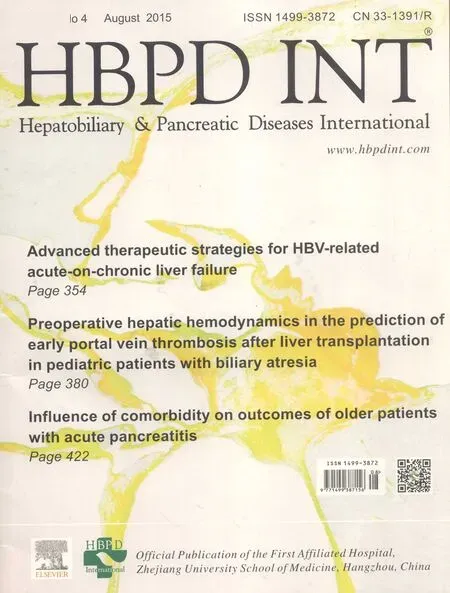 Hepatobiliary & Pancreatic Diseases International2015年4期
Hepatobiliary & Pancreatic Diseases International2015年4期
- Hepatobiliary & Pancreatic Diseases International的其它文章
- Meetings and Courses
- A liver donor with double hepatic artery aneurysm: a saved graft
- Impact of venous thromboembolism on the natural history of pancreatic adenocarcinoma
- Pancreaticoduodenectomy with portal vein/superior mesenteric vein resection for patients with pancreatic cancer with venous invasion
- Influence of comorbidity on outcomes of older patients with acute pancreatitis based on a national administrative database
- A serum metabolomic analysis for diagnosis and biomarker discovery of primary biliary cirrhosis and autoimmune hepatitis
